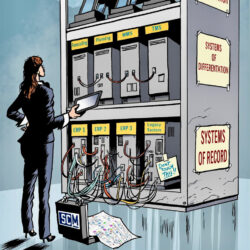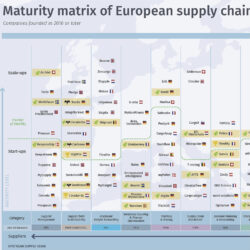Co-creation is a key reason for choosing start-ups

Why do some businesses prefer to work with a supply chain start-up rather than an established software vendor? Consultant Peter Schram had posed that question to several companies, and shared his findings during a recent Supply Chain Media webinar. He discovered that besides innovation, the start-up’s drive and the ability for the customer to influence the final software solution are other key reasons. “Some companies reserve a portion of their IT budget for experimenting together with start-ups,” said Schram.
By Marcel te Lindert
Supply Chain Media has been publishing its annual SCM IT Subway Map since 2012. The map shows subway lines representing various software categories: from warehouse management systems (WMS) to sales & operations planning (S&OP), and from supply chain network design to risk management. Software vendors are visualized as stations along a subway line based on their implementations in that particular category. “In other words, the subway map doesn’t show the functionality offered by vendors, but rather their number of proven implementations in each category,” explained Martijn Lofvers, chief trendwatcher at Supply Chain Media and ‘architect’ of the IT Subway Map.
New subway lines are regularly added to the map, such as the line for real-time transportation visibility. “At the onset of the pandemic in 2020, every company needed real-time visibility, especially in the context of international transportation. Software vendors such as FourKites, Project44, Shippeo and Wakeo burst onto the scene and succeeded in attracting numerous investors in a short space of time. In the United States, Project44 raised as much as $420 million in funding and FourKites $241 million. Meanwhile, in France, Shippeo and Wakeo raised $40 million and $13 million respectively,” said Lofvers.
New subway stations
Another new subway station relates to software for recording and reporting carbon emissions. As of next year, publicly traded European companies will be required to measure and report their emissions. “This means that they need software, because otherwise auditors will not be able to check and approve their quarterly reports. It’s no coincidence that a scale-up like Sweep has managed to raise an impressive €100 million since being founded in 2020. This category is attracting a lot of big investments,” stated Lofvers.
Other subway lines have been on the map for years but are now seeing the addition of new stations, especially in the area of supply chain planning. Lofvers: “That’s where we see many new players emerging, notably often from France and Belgium. They are all cloud-based solutions and often use artificial intelligence. One example is Lokad, a specialist in statistical and probabilistic forecasting that incorporates the impact of changing lead times into the forecast. This is very relevant because – as we’ve seen in recent years – lead times are constantly changing.”
From start-up to scale-up
Comparing the various editions of the IT Subway Map reveals a steady stream of new start-ups. Some of them mature over time into scale-ups and gain a permanent position on the Subway Map. “A start-up is a fast-growing company that aims to meet a need with a new product. They often start with an idea, which they then try to translate into a reproducible and scalable product,” said Peter Schram, a former analyst at Gartner and founder of Breakthrough Advisory. “That process is not without its challenges. But if they manage to reach the tipping point, things can move quickly and they enter a period of rapid growth.”
Schram presented a chart by Bessemer Venture Partners showing supply chain to be one of the most interesting sectors for investors. Schram had asked a number of investors why. “They regard supply chain as a very large market with a relatively low degree of digitization and still widespread use of Excel spreadsheets. It’s a market that has great challenges, and therefore great opportunities. And it’s a market in which technology can be used to translate smart ideas into must-have products.”
Prefer to partner up with start-ups
Besides gaining the investors’ perspective, Schram examined three cases to find out why large, internationally active companies are so keen to work with start-ups. The first was glass manufacturer Saint-Gobain, which uses software from start-up Flowlity for short-term operational planning. Secondly, lubricants manufacturer Q8Oils is using the demand planning tool from Garvis to better respond to changing demand patterns following the COVID-19 pandemic. Last but not least, beer brewer AB InBev is working with GenLots to optimize its highly disparate inventory of packaging materials at different production sites. “In many cases, these companies could also have chosen established software vendors, yet they prefer to partner up with start-ups. Why?” asked Schram.
There are several reasons for this, he said. For one thing, companies are interested in start-ups’ new ideas or clever algorithms. “There is always an interesting innovation that they are eager to try,” Schram explained. “Another reason is co-creation. Start-ups rarely have a fully developed product, which gives both parties the opportunity to develop a solution together. This is interesting for the start-up because they can learn a lot from the customer. And it’s interesting for the customer because it results in a solution that optimally meets their specific needs.”
Very different energy
Another reason is the enthusiasm and service-focused nature of start-ups. A company that chooses a proven solution from an established software vendor often feels like just another customer. “Working with a start-up gives a very different energy,” Schram stated. “The pricing model is another advantage. Start-ups often offer a cloud-based solution and a software-as-a-service (SaaS) subscription, so companies don’t have to go through complex investment procedures. They also tend to be fast and flexible – some solutions can be implemented within just a few days – and have specific, interesting knowledge.”
Based on his research, Schram had some valuable tips, including to be open and honest with the start-up and to dare to experiment. He reminded the webinar participants that the solution does not have to be perfect right away, as long as there is a steep learning curve. Therefore, companies should stay pragmatic and focus on concrete results rather than trying to take overly ambitious steps. “It also struck me that the companies I surveyed reserve part of their IT budget for experimenting together with start-ups. And they realize that it’s better to partner with multiple software vendors rather than trying to find one supplier to do everything.”
Cast off the shackles of ERP
Lofvers underscored the latter point, not least because he sees many organizations struggling with an ERP system that has limited capabilities. “Stop it. Create a data lake that allows you to extract all the necessary planning data from the ERP system. With the extra data layer, you can implement solutions from start-ups much faster, enabling you to cast off the shackles of ERP and respond to sector developments faster,” stated Lofvers. He concluded with an urgent piece of advice: don’t rely on PowerPoint presentations, but ask companies for references and live demonstrations. “It’s just like buying a new car. Take a test drive as soon as possible, before making a decision.”










